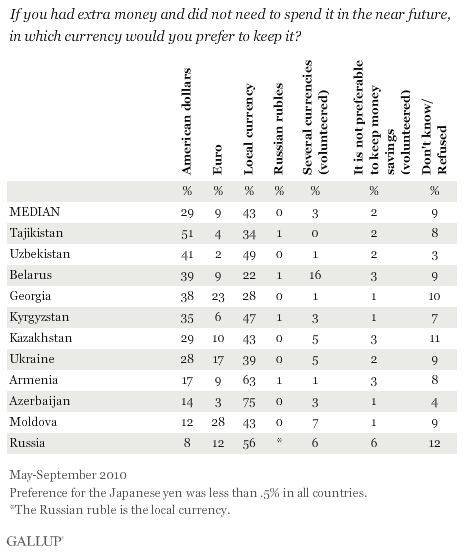WASHINGTON, D.C. -- Residents of former Soviet Union countries in 2010 for the most part said they would prefer to keep any extra money they have in their local currency, but they preferred U.S. dollars over euros by a margin of 29% to 9%. Hardly any residents would keep their extra funds in Russian rubles.

The findings are from ���۴�ýsurveys conducted in Armenia, Azerbaijan, Belarus, Georgia, Kazakhstan, Kyrgyzstan, Moldova, Russia, Tajikistan, Ukraine, and Uzbekistan between May and September 2010. The responses show the relative strength of the local currency, the U.S. dollar, the euro, and the Russian ruble in terms of how consumers perceive them. ���۴�ýalso asked about the Japanese yen, but less than .5% of respondents in any country selected it.
It is important to note that these data were collected in 2010, and do not reflect the latest fiscal challenges facing the eurozone countries of Greece, Ireland, Portugal, Italy, and Spain as well as the U.S. Gallup's 2011 update on this question later this year will reveal whether these sentiments in the former Soviet countries have shifted.
U.S. Dollar Still the Cash Cow
Ten of the 11 countries surveyed use the U.S. dollar for major financial transactions, including the purchase or rental of property or vehicles, with only Moldova relying instead on the euro for transactions such as these. This reality may explain residents' tendency to prefer U.S. dollars, though it is also possible that residents' preference also helped establish the dollar as the transactional currency of choice. Still, the differences across countries reveal the U.S. dollars' relative strength and weakness from a behavioral economic perspective beyond measurable transactions. Residents of Tajikistan, Uzbekistan, Belarus, Georgia, and Kyrgyzstan were the most likely to prefer to keep money in dollars, while residents of Russia were the least likely.
Like others in the region, residents of Tajikistan, Uzbekistan, and Kyrgyzstan almost universally reject Russian rubles, even though residents of these countries heavily depend on temporary work in Russia. For example, 39% of Tajikistan residents say someone in their household works temporarily in another country and report at least one adult working in Russia.
Banking Woes in Belarus, Success Story in Azerbaijan, and Different Sides of the Coin in Georgia and Russia
Belarusians' relatively low 22% preference for their own local currency may be related to its sharp devaluation in recent years. The Central Bank of the Republic of Belarus raised the exchange rates on its currency in January 2009, lowering the exchange rate against the U.S. dollar by 20%. The Central Bank this May lowered the exchange rate against the U.S. dollar even more sharply, making it likely that views of the local currency have only grown more negative.
In contrast, Azerbaijanis were the most likely to want to keep money in their local currency, with 75% expressing this preference. The Azerbaijani manat remained stable during the global financial crisis, partly because the Central Bank of Azerbaijan lowered interest rates from 15% to 2%, increased the allowable amount of foreign ownership in the banks to 50%, and dropped reserve requirements down to a historically low .5%. Azerbaijan continues to show positive GDP growth and this week reported that its strategic monetary reserves of $40 billion are seven times the value of its foreign debts.
Georgia's strong relations with the U.S. are evident in that a relatively high 38% of residents prefer the U.S. dollar over their own currency and the euro. In contrast, 56% of Russians choose their own currency, and more choose the euro than choose the U.S. dollar.
Implications
As economies worldwide struggle to regain their economic footing following the global economic collapse, Gallup's behavioral economic data on how populations view different currencies provide a unique measure of economic strength and weakness. The tendency to prefer the U.S. dollar over the euro in former Soviet Union countries in 2010 suggests the dollar still carries clout despite the euro's higher exchange rate versus the dollar. Still, with the euro weakening in recent weeks and economic challenges persisting in several eurozone countries, this measure will be one to watch as ���۴�ýcollects new data each year.
For complete data sets or custom research from the more than 150 countries ���۴�ýcontinually surveys, please contact SocialandEconomicAnalysis@gallup.com or call 202.715.3030.
Survey Methods
Results are based on face-to-face interviews with 1,000 adults, aged 15 and older, conducted in May-September 2010 in Armenia, Azerbaijan, Belarus, Georgia, Kazakhstan, Kyrgyzstan, Moldova, Tajikistan, Ukraine, and Uzbekistan and 2,000 adults in Russia. For results based on the total sample of national adults, one can say with 95% confidence that the maximum margin of sampling error is ±4 percentage points. The margin of error reflects the influence of data weighting. In addition to sampling error, question wording and practical difficulties in conducting surveys can introduce error or bias into the findings of public opinion polls.
For more complete methodology and specific survey dates, please review .
